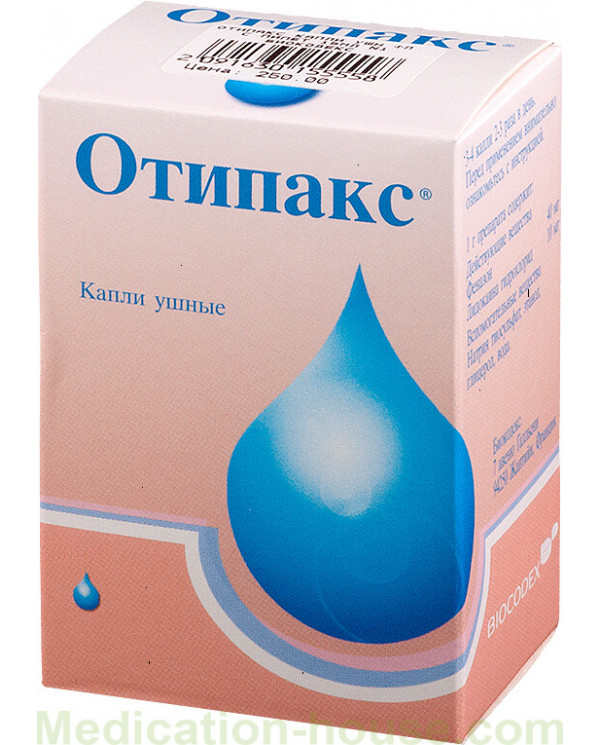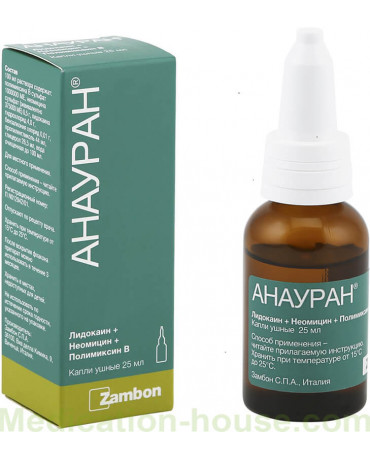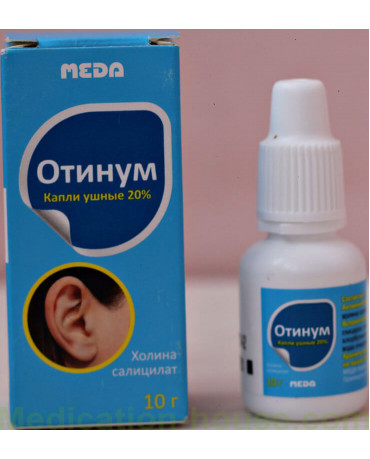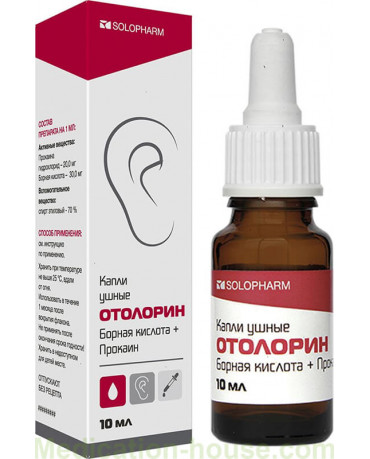Instruction for Otipax
You can buy Otipax here
Composition, release form
The main active ingredients: phenazine (non-steroidal anti-inflammatory drug), lidocaine hydrochloride (analgesic). Additional components that do not have medicinal properties:
sodium thiosulfate;
purified water;
glycerol;
ethanol.
The drug is packaged in dark glass vials with a volume of 15 ml with a plastic tip and a rubber top for easy dispensing. A medication with an alcohol smell, has no color, but a yellowish tint is allowed.
One package contains a bottle of drops, a pipette tip and instructions for use.
Pharmachologic effect
The effect of the drug is due to the content of two active components:
Lidocaine is a local anesthetic. It prevents the passage of the pain impulse, due to antagonism with calcium and sodium of the sheath of the nerve fiber, as a result of which the pain syndrome decreases.
Phenazine is an analgesic and non-steroidal anti-inflammatory drug. Mechanism of action: inhibition of prostaglandin synthesis and blocking of cyclooxygenase, which is manifested by inhibition of inflammation processes.
The interaction of the two components provides a fast, long-lasting pain relieving effect. Otipax drops stimulate the dilution and removal of secretions from the ear cavity.
The drug acts only locally, its components are not absorbed into the systemic circulation and do not have a harmful effect on organs and systems. The drops interact locally with the mucous membranes and skin of the ear (in the absence of damage to the tympanic membrane).
Indications and restrictions for use
The drug is used for symptomatic treatment and relief of ear pain in the following diseases:
otitis media that arose as a complication after the flu;
barotraumatic otitis media;
acute otitis media (catarrhal form).
The drug is approved for children with otitis externa, eustachitis, as a preventive measure after removing a foreign body from the ear.
Otipax is contraindicated in case of intolerance to its components and the presence of damage to the eardrum. The use of the drug with a damaged membrane may cause irritation of the mucous membranes and impairment of hearing.
Instructions for use
Before instilling drops, it is necessary to clear the ear canal of excess earwax and secretions (if any). For this purpose, it is better to use a cotton swab with a stopper to avoid pushing the wax into the ear cavity and the formation of a wax plug. Before use, you need to wash your hands with soap, open the bottle with drops and put on a pipette tip. The drops must be warmed in the hands to room temperature to prevent irritation.
Adult use
Before instillation, you need to lie on your side, pull the earlobe back and up (for better penetration of drops) and drip 3 to 4 drops into the ear canal. After instillation, you must lie down for 10 minutes. To warm the ear cavity and prevent drops from flowing out, you can close the ear canal with cotton wool. The number of procedures per day is 2 - 3 times, the maximum duration of the course of treatment is 10 days.
Application in children
Otipax drops are produced in one form for children and adults. The rules for preparation and introduction are similar. Babies under 1 year old are instilled 1 - 2 drops into a sore ear, babies from 1 to 2 years old drip 3 drops. For children over three years of age, 4 drops. The number of instillations per day 2 - 3 times, the duration of treatment is not more than 10 days.
For newborns, drops can be dripped onto a cotton or gauze cloth and inserted into the sore ear. After the instillation of the product, the ear canal is closed with a cotton swab smeared with petroleum jelly to prevent evaporation, dripping and increase the effectiveness of the drug.
Use in pregnant and lactating women
The medication is not absorbed into the general bloodstream and does not have a harmful effect on the fetus, therefore, drops are not contraindicated during pregnancy and breastfeeding, provided the eardrum is intact.
Use of funds during a flight
The inflammatory process in the middle ear, which occurs when atmospheric pressure drops, is called aerotitis.
To prevent the development of aerootitis and injury to the tympanic membrane during the flight, it is necessary to drip 1 - 2 drops of Otipax into each ear before departure and landing.
Contraindications, side effects
Side effects are extremely rare, and more often they are associated with intolerance to the substances that make up the composition. Side effects:
redness of the ear cavity;
itching;
burning;
swelling of the auricle;
hearing loss.
When these symptoms appear, the drug is discontinued. Contraindications for use: intolerance to the components of the drops, damage to the eardrum.
Overdose, interaction with other drugs
There were no cases of overdose, since the drug acts only in the ear cavity and does not enter the systemic circulation. But, theoretically, an overdose can manifest itself as hearing loss and disruption of the vestibular apparatus.
The manufacturer indicates that no negative interaction of Otipax ear drops with other drugs has been found. With the simultaneous use of Otipax and other ear drops, it is necessary to adhere to an interval of 15 - 20 minutes.
Special instructions
The medication contains an active ingredient that can give a positive result for doping in athletes. Drops do not affect psychomotor reactions, so there are no restrictions on driving.
With the appearance of side effects, the absence of positive dynamics, the persistence of symptoms of the disease, the use of the drug is discontinued and, as prescribed by the doctor, they are replaced with similar ones in action or constituent components.
Before using the product, it is necessary to consult an otolaryngologist to determine the integrity of the tympanic membrane.
Expiration date, storage
Ear drops are stored in a place protected from direct sunlight and children at a temperature not exceeding 30 C. The shelf life from the date of manufacture of the drug indicated on the package is 5 years. After opening the bottle, Otipax drops retain their therapeutic effect for up to 6 months.
After the specified period, the medication must be disposed of, since the severity of its action is reduced or absent. The drug is dispensed from pharmacies without a prescription form.
Feedback on the use of Otipax
Anna, 27 years old
My family and I love to travel, so we often fly by plane. After the flights, my daughter's ears begin to hurt. The doctor advised us to bury Otipax drops before takeoff and after landing. After the drops, my daughter's ears stopped hurting, and I drip them myself during the flight for prevention.
Ivan, 29 years old
After a severe cold, both ears began to hurt, the otolaryngologist said that otitis media. Since the eardrum was not damaged, Otipax was prescribed. I was treated with them for a week and the otitis media was gone, there were no unpleasant sensations, I dripped 3 drops 3 times a day.
Anastasia, 28 years old
My baby was 8 months old when he developed otitis media in the right ear. The pediatrician prescribed Otipax. I could not drip the drops, the baby was crying and did not want to go to bed, so I dripped the drops onto a cotton swab and inserted it into his ear. After 2 days, the daughter began to sleep peacefully, a week later we went to see the doctor again, there was no otitis media. The only negative for me is the expensive price of drops.
Terms of sell
You don't need a prescription from a doctor to buy Otipax.




